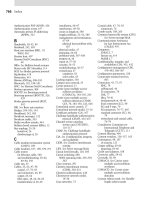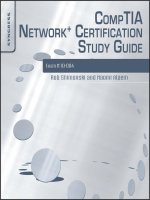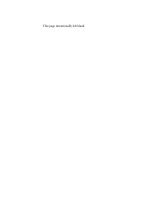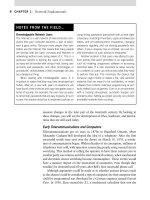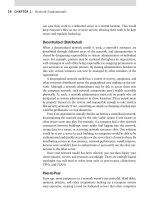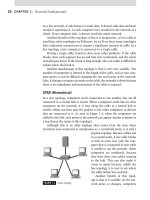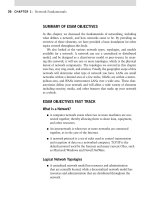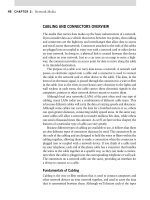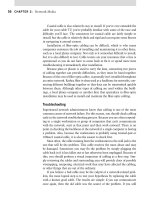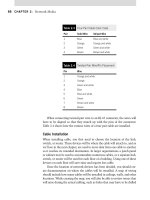CompTIA Network+ Certification Study Guide part 32 docx
Bạn đang xem bản rút gọn của tài liệu. Xem và tải ngay bản đầy đủ của tài liệu tại đây (150.12 KB, 10 trang )
CHAPTER 7: TCP/IP and Routing 296
the number is 1. How do we get to 2? We set the next bit, bit 1, to 1 and
reset bit 0 to 0. This is just like in the decimal numbering system in which
you count, in the right-most position, from 0 to 9. After nine, you move to
the next position, set it to 1 and reset the first position to 0, resulting in the
decimal number 10. Binary works the same way, except that each bit posi-
tion can be only 0 or 1, thus you need more positions in order to represent
decimal numbers.
To create a binary number, we set the desired bit to 1. For instance, to
represent the number 128, we would set the eighth position, or bit 7 (remember,
we’re counting from 0 to 7, not 1 to 8), to 1. What if we wanted to create the
number 132? We’d set bit 7 and bit 2 to 1. The rest of the bits would remain 0
as shown in Table 7.5. Any number can be expressed this way, limited only by
the number of bits in a defined field (in TCP/IP, we use only eight bits for each
number).
To convert a binary number to decimal, add the value of each bit position
set to 1. Thus, the binary number 10000100 converts to decimal 132.
To convert a decimal number to a binary number, look at the decimal
number and find the largest binary bit represented. If we want to convert 184
to binary, we do the math shown in Table 7.6. For each number we subtract,
we set the corresponding bit to 1.
Using this example, 184 can be notated as 10111000 with the 128, 32,
16, and 8 bits set to 1, and the rest set to 0. As you become accustomed to
working with both binary and decimal conversions, you may not need to do
this lengthy math; eventually you might simply be able to do this in your
head. Let’s look at Exercise 7.1, which will help you master the concept of
converting decimal and binary numbers.
Table 7.4
Binary and Decimal Values
Bit number Bit 7 Bit 6 Bit 5 Bit 4 Bit 3 Bit 2 Bit 1 Bit 0
Notation 2
7
2
6
2
5
2
4
2
3
2
2
2
1
2
0
Decimal value 128 64 32 16 8 4 2 1
Table 7.5
Setting Bits to Create Dotted Decimal Values
Bit number Bit 7 Bit 6 Bit 5 Bit 4 Bit 3 Bit 2 Bit 1 Bit 0
Notation 2
7
2
6
2
5
2
4
2
3
2
2
2
1
2
0
Decimal value 128 64 32 16 8 4 2 1
Bit values for 132 1 0 0 0 0 1 0 0
Understanding IP Addressing 297
EXERCISE 7.1 Converting Decimal and Binary Numbers
This exercise is designed to reinforce what we’ve learned about binary and
decimal conversions. Remember, you will not get a question that explicitly
asks you to do these steps, but you may be required to do them to figure out if
a subnet mask is incorrectly shown on the exam. Understanding this conver-
sion process is the cornerstone of understanding the IP addressing system.
Convert the following number to binary: 24. Using the technique 1.
described in this section, we first write out the bit values of an octet:
128 64 32 16 8 4 2 1. Next, we look for the highest value that is
less than the number given. In this case, the highest number is 16.
We set bit 4, which is equivalent to decimal 16, to 1. Next we subtract
16 from our number: 24 16 8. We set bit 3, equivalent to decimal
8, to 1. We subtract 8 8 0 and we have no remainder. Thus, we
have the 16 and 8 bits set to 1, and all other bits are zero: 00011000.
Convert the following number to decimal: 00001011. In this case, 2.
we have to do just the opposite of what we did in the first conver-
sion. Now, we write the bit values of the octet and add up any bit
values set to 1. The octet numbers are 128 64 32 16 8 4 2 1. The
following bits are set to 1: 8, 2, 1. We add 8 2 1 to yield 11,
the decimal equivalent of this binary notation.
Convert the following number to binary: 255.0.132.2. Let’s work 3.
on each octet, one at a time. Let’s begin with the left-most octet,
255. By now, you might recognize that the 255 is all 1s. If not, this
Table 7.6
Calculating Binary Bits from Dotted Decimal
Converting Decimal to Binary Subtraction
Decimal number 184
Largest binary number (in octet) that can be subtracted from this number –128
Remainder 56
Largest binary number that can be subtracted –32
Remainder 24
Largest binary number that can be subtracted –16
Remainder 8
Largest binary number that can be subtracted –8
Remainder 0
CHAPTER 7: TCP/IP and Routing 298
is a handy fact to remember. To calculate its value, we begin by
subtracting the highest bit value less than 255. (The bit value being
subtracted is in bold to make it easier to read). In this case, that’s
128. 255 128 127. Again, we subtract the largest bit value:
127 64 63. Repeating this process we get: 63 32 31. 31
16 15. 15 8 7. 7 4 3. 3 2 1. 1 1 0. For each
bit value we subtract (128, 64, etcetera) we set the corresponding
bit position to 1. Thus, the binary equivalent is 11111111. The
next octet (x) is easy; it’s all 0s. The octet is written as 00000000.
The third octet (y) is equal to 132. Using our subtraction tech-
nique, we know that the 128 bit will be set to 1. 132 128 4.
Thus, we set the 4 bit to 1, yielding this octet: 10000100. The final
octet (z) is 2. This is easy to figure out – the second bit is set to 1,
the rest of the bits are 0. The octet is 00000010. Putting this all
together, we have 11111111.00000000.10000100.00000010.
Convert the following number to dotted decimal notation: 4.
00001000.00001111.00101101.10101010. In this case, we need to
convert this number to dotted decimal by adding the values of each
bit position set to 1. Again, we’ll start on the left. In the first octet,
the only position set to 1 is the 8 position. In the second octet, the
right-most four bits are set to 1. If you’re becoming familiar with
the different bit patterns, you’ll immediately recognize 15. Other-
wise, add the bit values of 1, 2, 4, and 8 together to yield 15. The
next octet (y) has the following bit positions set to 1: 32, 8, 4, 1. If
you have difficulty with this, write out the bit values 128 64 32 16
8 4 2 1, and then write out the octet underneath. You’ll see which
bit positions are set to 1 and you can add those values. In this case,
it equals 45. The final octet, z, has the following bit positions set
to 1: 128, 32, 8, 2. Adding these results yields 170. The resulting
dotted decimal notation for this is 8.15.45.170.
Convert the following number to binary: 112.64.117.3. Again, we’ll 5.
use our subtraction method to find the largest bit value that is lower
than the number and subtract it from the number. We’ll repeat
the process until the remainder is 0. For each number we subtract
(shown in bold), we set the corresponding bit to 1. Our answer looks
like this:
First octet (w): 112 64 48. 48 32 16. 16 16 0
01110000
Second octet (x): 64 64 0 01000000
Understanding IP Addressing 299
Third octet (y): 117 64 53. 53 32 21. 21 16 5. 5 4
1. 1 1 0 01110101.
Fourth octet (z): 3 2 1. 1 1 0 00000011
Putting the four octets together yields this dotted decimal notation:
01110000.01000000.01110101.00000011.
Although the adding and subtracting may seem simplistic, it’s impor-
tant to practice this over and over, so that you can actually look at an octet
and add up the values in your head or at least recognize the values and add
them with a calculator. It’s simple math that simply requires close attention
to detail. It’s easy to inadvertently miss a bit position. Writing down the
sequence can help you avoid these kinds of errors.
It’s a good idea to practice converting binary to decimal, as you’ll need
to know how to do this when working on your network and as well as the
Network exam. The key is to break each octet down individually and
check your work by adding up the value of the bits you’ve set. This will
help to ensure that your math and your logic are both correct and will
reduce common errors when you set up subnets, subnet masks, and other
IP addresses.
Network ID and Host ID
Now that you’ve learned how to convert binary to decimal and back again,
let’s look at the principals underlying networking with IP addresses. An IP
address has two elements, the network address and the host address. As
we’ve discussed, the IP address is a unique address assigned to a computer
Test Day Tip
After you’re situated in the exam room at the testing computer, take a minute or two
before starting the test to write down all your tips and tricks for the exam on the blank
paper provided (and make sure that you do this before you start the exam because
your allocated time doesn’t begin until you actually start). It’s a good idea to write down
128 64 32 16 8 4 2 1. Then, when you’re asked a question about binary or decimal
conversions, you won’t make an error simply because you forgot that 32 is in between
16 and 64. If you practice these conversions enough, you’ll actually begin to recognize
patterns immediately – you’ll know that 00001111 is 15 and 00001010 is 10, and so
on. It’s not difficult math, but you have to pay very careful attention to the details. One
missed bit changes everything!
CHAPTER 7: TCP/IP and Routing 300
or device (printer, router, etc.) connected to the network. The network
address is a fixed address used to identify a common network. Within each
IP address is a network address (shared by all computers on that network)
and a unique host address. When combined, the result is a single unique IP
address on the network.
All hosts (also called nodes when talking about connected network
devices) on the same network segment must have the same network ID.
A good analogy is the U.S. zip code system. There are many houses on a
street, each with a unique street address (host ID) but all of them have the
same zip code within a certain area (network ID). The street address com-
bined with the zip code is a unique combination that identifies a particular
house or building just as an IP address identifies a particular host. Figure 7.3
illustrates this concept.
Large networks are usually divided by routers. Routers (first covered in
Chapter 3, “Network Devices”) separate one segment from another and
only pass along data destined for external networks (those on the other
side of the router). If the data is intended for a host within the segment,
FIGURE 7.3 Network And Host IDs.
Understanding IP Addressing 301
the router does not forward it to the external segment(s). This reduces net-
work traffic and increases response times. In order for this to work, how-
ever, each segment of the network must have a unique identifier, which
is the network address or network ID. Primary network IDs are managed
by the Internet Network Information Center (InterNIC), an organization
that manages top-level network addresses to prevent two organizations
from using the same network ID. Two networks connected to the Internet
cannot use the same network ID (networks that are completely stand-
alone and have no connection to the Internet can use any network ID you
wish).
Originally, network IDs were divided into classes: Class A, B, C, and D.
Each class had a specific purpose and a defined range of allowable addresses.
The goal was to provide for three common scenarios in networking:
Small number of very large networks (large number of nodes per
network)
Moderate number of medium-sized networks
Large number of very small networks (small number of nodes per
network)
This class-based system worked well for quite some time. However, in
the 1990s, when the Internet boom period (the massive growth of the Inter-
net) began, it became clear that the addressing scheme would not support
the many hundreds of thousands of networks that were popping up (and get-
ting connected to the global network) around the world. A new classless sys-
tem was devised. It still uses IP addressing fundamentals, but it extends the
original concept. The class-based system now often is referred to as classful,
to differentiate it from the classless addressing system. We’ll discuss the
classless system (also called variable length subnet masking or VLSM) later
in this chapter. For now, let’s look at the class-based system to understand
network addressing fundamentals.
The 32-bit IP address is subdivided into two portions: the network address
space and the host address space. The use of 32-bits does not change, but
the use of the bits within the 32-bit address changes to define four classes
of addresses. There are currently five defined address classes: Class A, B, C,
D, and E. Microsoft Windows Server 2003 supports four address classes: A,
B, C, and D. It does not support Class E addresses, which are considered
experimental at this time. In addition, there are several guidelines regarding
allowable or legal addresses for network IDs and for host IDs. As we learned
earlier, the notation used is called dotted decimal and is also represented as
w.x.y.z to denote the four octets used.
CHAPTER 7: TCP/IP and Routing 302
Rules for Network IDs
The following rules apply to creating or using network IDs in a class-based
system.
Network IDs cannot begin with 127 as the first octet, such as
127.14.102.6. 127.x.y.z is reserved for loopback addresses. A loop-
back address is used to test IP software on the host computer and is
not associated with the computer’s hardware.
A Network ID cannot have all bits set to 1. This configuration is
reserved for broadcast addresses.
A Network ID cannot have all bits set to 0. This configuration is
reserved for indicating a host on the local network.
A Network ID must be unique to the IP network. If you have three
network segments in your corporate network, each segment must
have a unique network ID.
Rules for Host IDs
The following rules apply to creating and assigning host IDs.
A host ID cannot have all bits set to 1. This configuration is
reserved for broadcast addresses.
A host ID cannot have all bits set to 0. This configuration is
reserved for the expression of IP network IDs.
A host ID must be unique to the network on which it resides.
Exam Warning
The 32-bit IP address is subdivided into two portions: the network address space and
the host address space. You must know how to identify IP addresses correctly on the
Network+ exam. You must also know how to identify an IP address by its class, as
well as its default subnet masks. Please pay very close attention to these areas as you
proceed through the text. A lot of the material here is to get you to learn how to do this,
not just memorize it for the exam. You can’t fake the understanding of IP address-
ing on the exam, and rote memorization is no cure either. You must be able to clearly
identify IP addressing issues on the Network+ exam and how to solve them. You will
not be asked to create an elaborate design for a complex network, but you may see
diagrams of segments that you need to work with. Understanding IP addressing will
help you to successfully navigate these questions and pass these section objectives on
the exam.
Understanding IP Addressing 303
Just like modern day humanity, there is obviously a class system with IP
addressing and this one is needed to keep the IP address space organized and
readily available for use. In the next section, we will cover the IP addressing
class system.
Class A Addresses
Class A addresses are designed for very large networks with few logical net-
work segments and many hosts. Class A addresses always have the high-
order bit (or left-most bit) set to zero. The first octet (the left-most eight
bits) is used to define the network ID. The host addresses use the second,
third, and fourth octets. This can also be represented as w network ID,
x.y.z host ID (using the convention that all IP addresses are composed of
four octets and represented as w.x.y.z). Let’s look at an example: 01110000
00000000 00001100 00001111 is a Class A address. The network ID (in bold)
is 112. The host ID is 0.12.15. Thus, this IP address is 112.0.12.15. Other
hosts on the same network would all have IP addresses that begin with 112.
With the high-order bit set to 0, by definition, a Class A address cannot
be greater than 127 because a value of 128 would require the left-most bit be
set to 1. To calculate the number of possible networks, use the formula 2
∧
n
or 2
n
, where n is the number of bits in the octet that can be used. In this case,
we cannot use the left-most bit, so n in this case is 7. 2
∧
7 or 2
7
equals 128.
However, we know that we cannot have a network set to 127 (loopback) and
we cannot have a network of all 0s or all 1s. Therefore, we have 126 useable
network addresses. We can also calculate how many possible host addresses
we have in a Class A network by using the same formula. In this case, we’re
using three octets for host IDs. Therefore, we have 2
24
or 16,777,216. Again,
we cannot use addresses of all 0s or all 1s, so we have 16,777,214 useable
host addresses available.
Class B
Class B addresses are used for medium-sized networks that have a moderate
number of hosts connected to them. Class B addresses always have the first
two high-order bits (left-most) set to 10. The Class B network ID uses the first
two octets for the network ID. This allows for more network IDs and fewer
hosts than a Class A network. Because it uses an additional octet for the net-
work, there is one fewer octet available for host IDs, reducing the number of
hosts that can be addressed on this network by approximately a factor of two.
Here’s a Class B IP address: 10010001 00001100 00001010 00001001.
This translates into 160.12.10.9. The first two octets (160.12) represent
the network ID and the last two octets (10.9) represent the host ID portion
CHAPTER 7: TCP/IP and Routing 304
of this IP address. Thus, the schema is w.x network ID, y.z host ID.
Notice that the two high-order bits are set to 10.
Class B networks use the first two octets for the network ID. However,
we cannot set the second bit to 1 (Class B left-most two bits must be 10).
Therefore, we can calculate that there are a total of 2
14
or 16,384 Class B
network addresses (16 bits for network ID, but we cannot use the first two
bits because they must be set to 10). As we are required to set the first two
bits to 10, we will not end up with a network address that is all 0s or all 1s;
therefore we do not need to subtract from our total network IDs to find avail-
able network IDs. To calculate the number of hosts on a Class B network, we
know that we use 16 bits (two octets) for the host ID. Thus, we have 65,536
total host IDs and we cannot use all 0s or all 1s, resulting in 65,534 available
host IDs on a Class B network.
Class C
Class C addresses are for small networks with few hosts. These addresses
have the first three high-order bits set to 110. Class C addresses use the first
three octets for the network ID and the last octet for the host ID. Using your
understanding of IP addressing at this point, how many host addresses will
be available in each Class C network? If you answered 256 (0 through 255),
you’d be close. If you add each bit (128 64 32 16 8 4 2 1), it
totals 256, but remember we cannot use an address of all 0s or all 1s. We’re
left with 254 possible addresses. The schema for the Class C IP address is
w.x.y network ID, z host ID.
Class C networks use the left-most three bits set to 110. To calculate
the number of networks available, we calculate the total bits available, in
this case 24 (three octets) 3 (first three bits must be 110) 21. Using
the formula 2
21
we see that the number of Class C networks is 2,097,152.
Again, because the left-most three bits must be set to 110, we do not need
to subtract for network IDs of all 0s or all 1s. As we saw, the number of host
IDs is 254 based on 2
8
2 256 2 or 254.
Class D and Class E
Class D is reserved for IP multicast addresses. The first four high-order bits
are set to 1110. The remaining 28 bits are used for individual IP multi-
cast addresses. Multicast Backbone on the Internet (MBONE) is an exten-
sion to the Internet that supports IP multicasts and uses Class D addresses.
MBONE allows a single packet to have multiple destinations and is most
often used in real-time audio and video applications. Multicasting will be
covered later in this chapter.
Understanding Subnetting 305
Class E addresses are reserved for future use. This class is considered
experimental and the addresses are defined as “reserved for future use.” The
first five high-order bits are set to 11110.
Address Class Summary
This is by far one of the most important sections for the Network exam. IP
addresses are 32-bit addresses divided into four octets. Each octet has eight
bits and a maximum value of 255, which is when all eight bits are set to 1.
Each address class defines the maximum number of networks (or subnets,
actually) and hosts. These are summarized in Tables 7.7 and 7.8.
UNDERSTANDING SUBNETTING
A Class A network could theoretically have 16,777,214 hosts. However, in a
real-world application, this would be impractical. Most networks are broken
down into smaller segments that are easier to manage. It is possible to assign
such a network, although it would be very flat, and very large by default. As
Table 7.7
Network Address Classes
Address Class Octets Used First Network ID Last Network ID Number of Networks
Class A 1 1.x.y.z 126.x.y.z 126
Class B 2 128.0.y.z* 191.255.y.z 16,384
Class C 3 192.0.0.z 223.255.255.z 2,097152
* Remember that a valid network address cannot begin with 127.0.0.0, which is reserved for loopback
addresses.
Table 7.8
Host Address Classes
Address Class Octets Used First Host ID Last Host ID Number of Hosts
Class A 3 w.0.0.1 w.255.255.254 16,777,214
Class B 2 w.x.0.1 w.x.255.254 65,534
Class C 1 w.x.y.1 w.x.y.254 254
Test Day Tip
It would be helpful for you to be able to recall this information (especially the default
address classes and ranges) for the Network+ exam. It’s always helpful to practice writing
this information down; therefore, when you get to the test center, you can jot this down
before the exam and have it handy while you are taking the exam.
